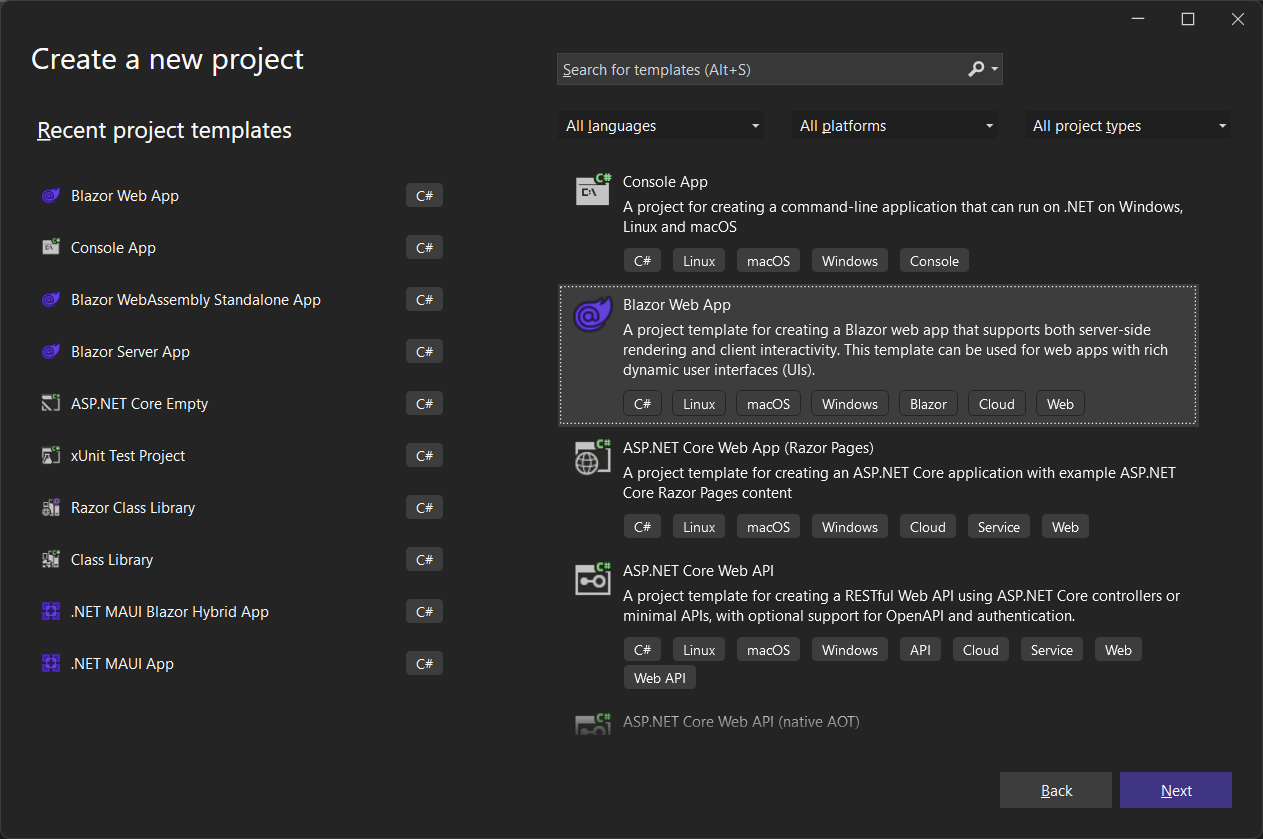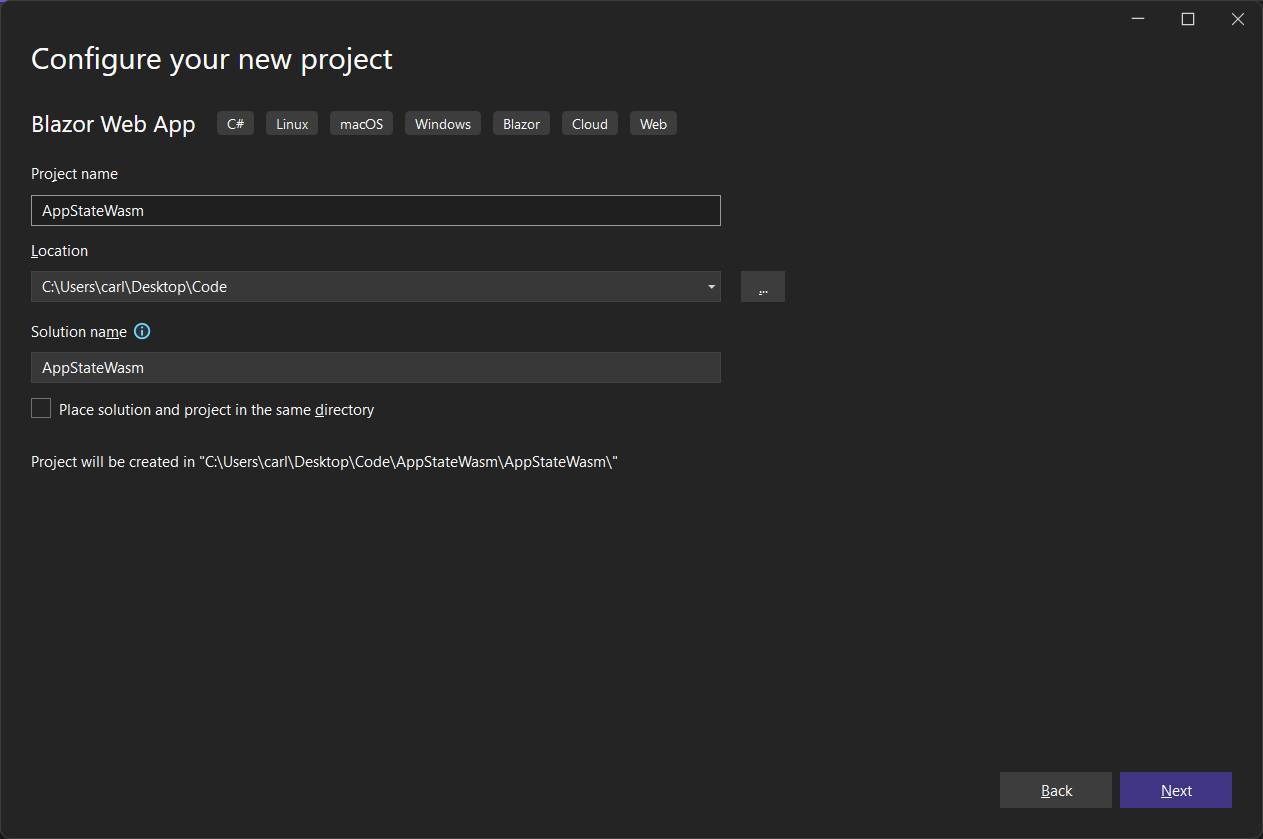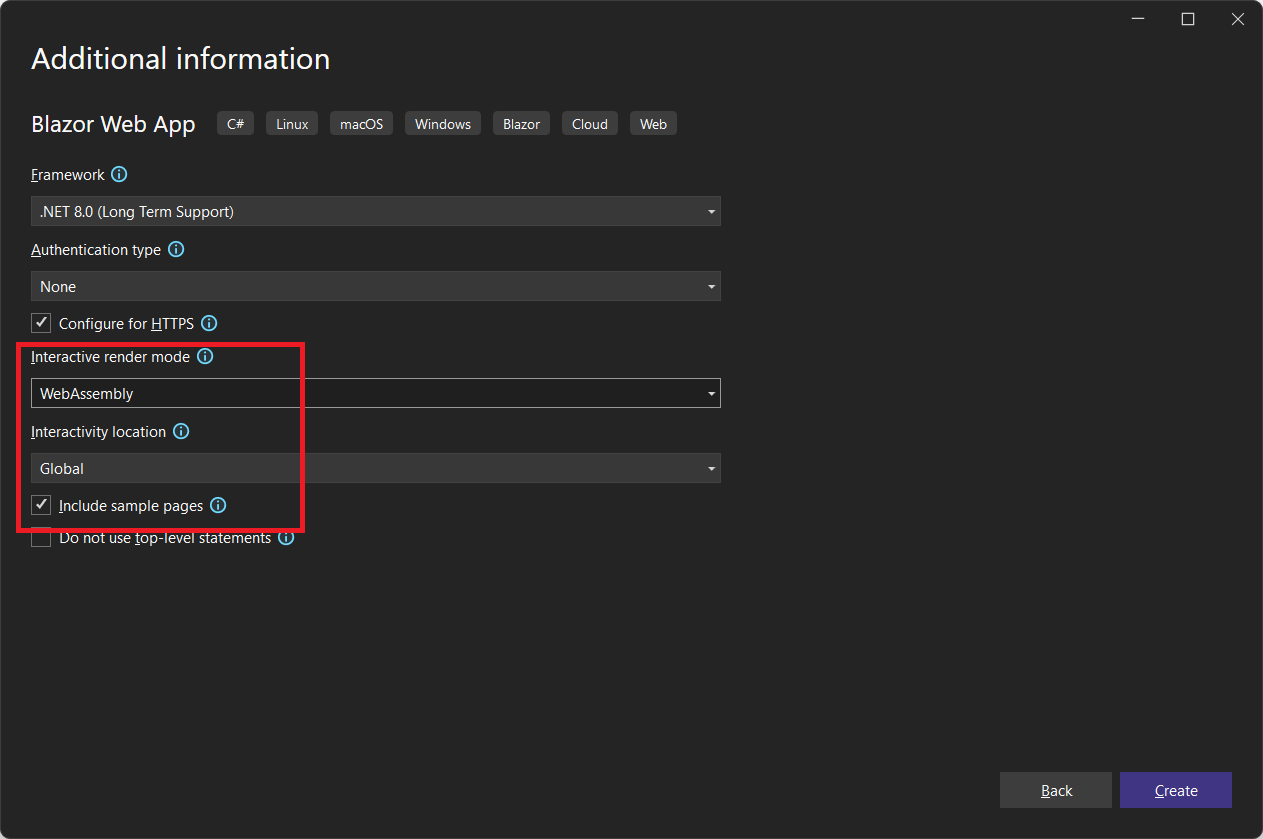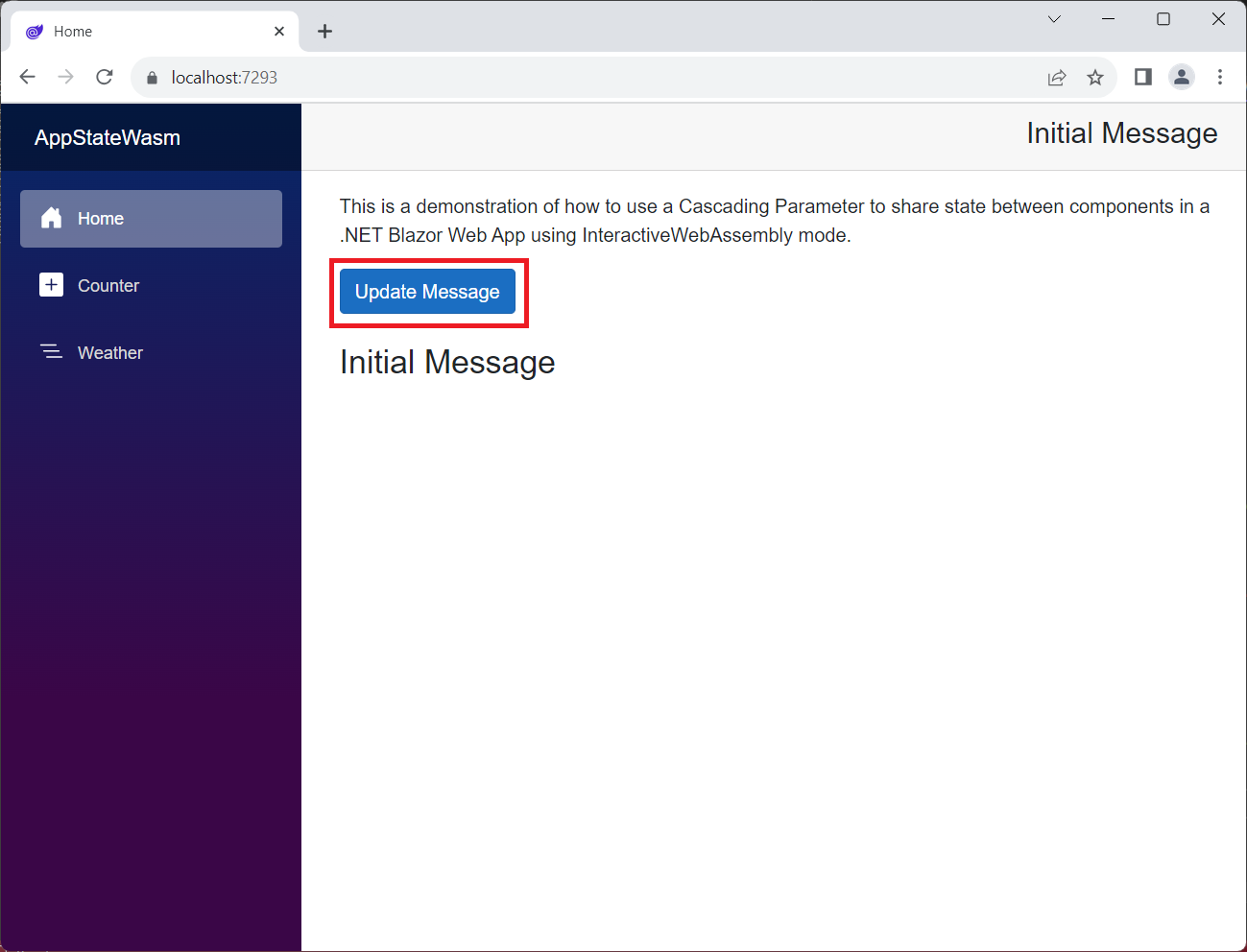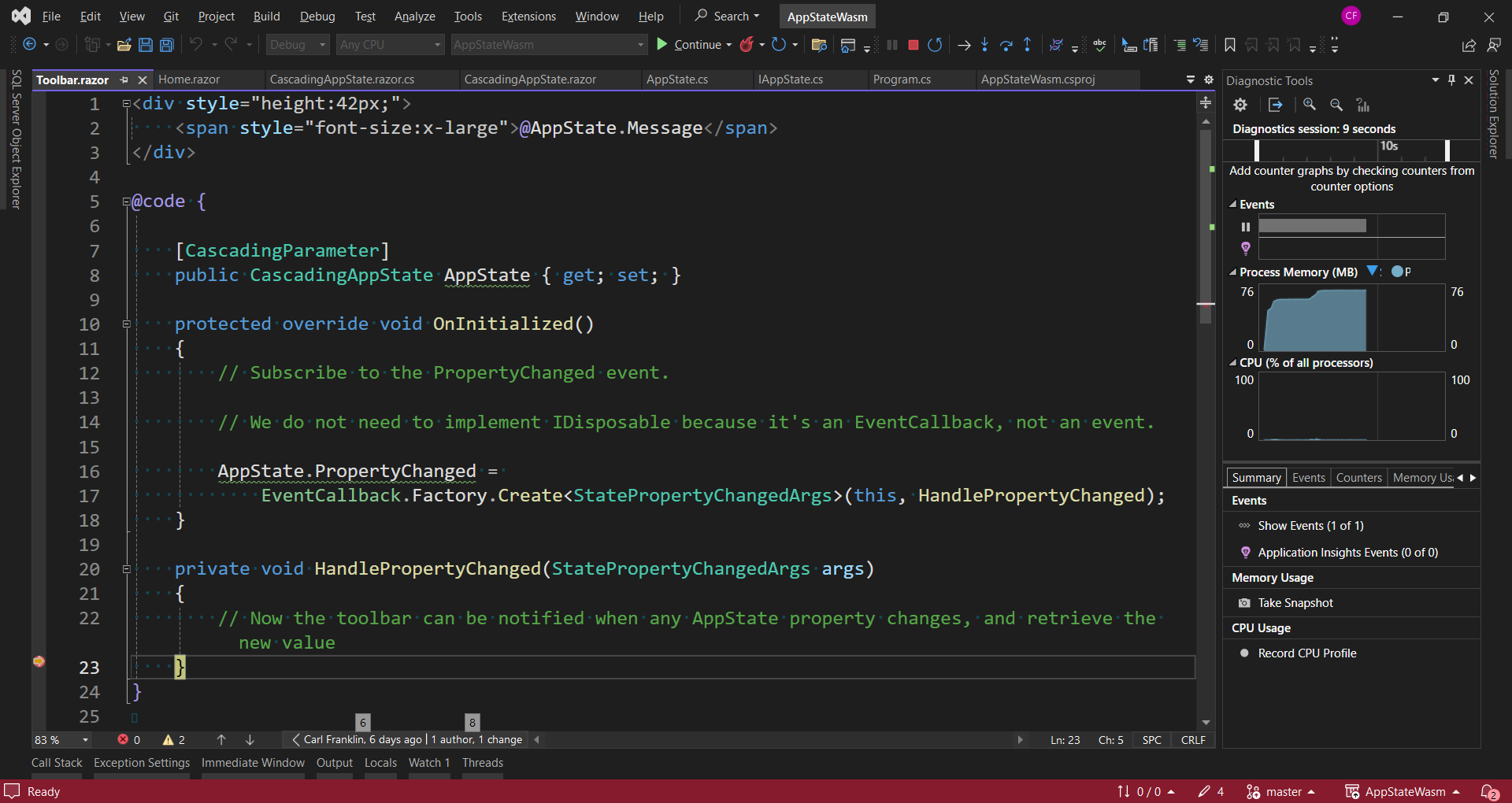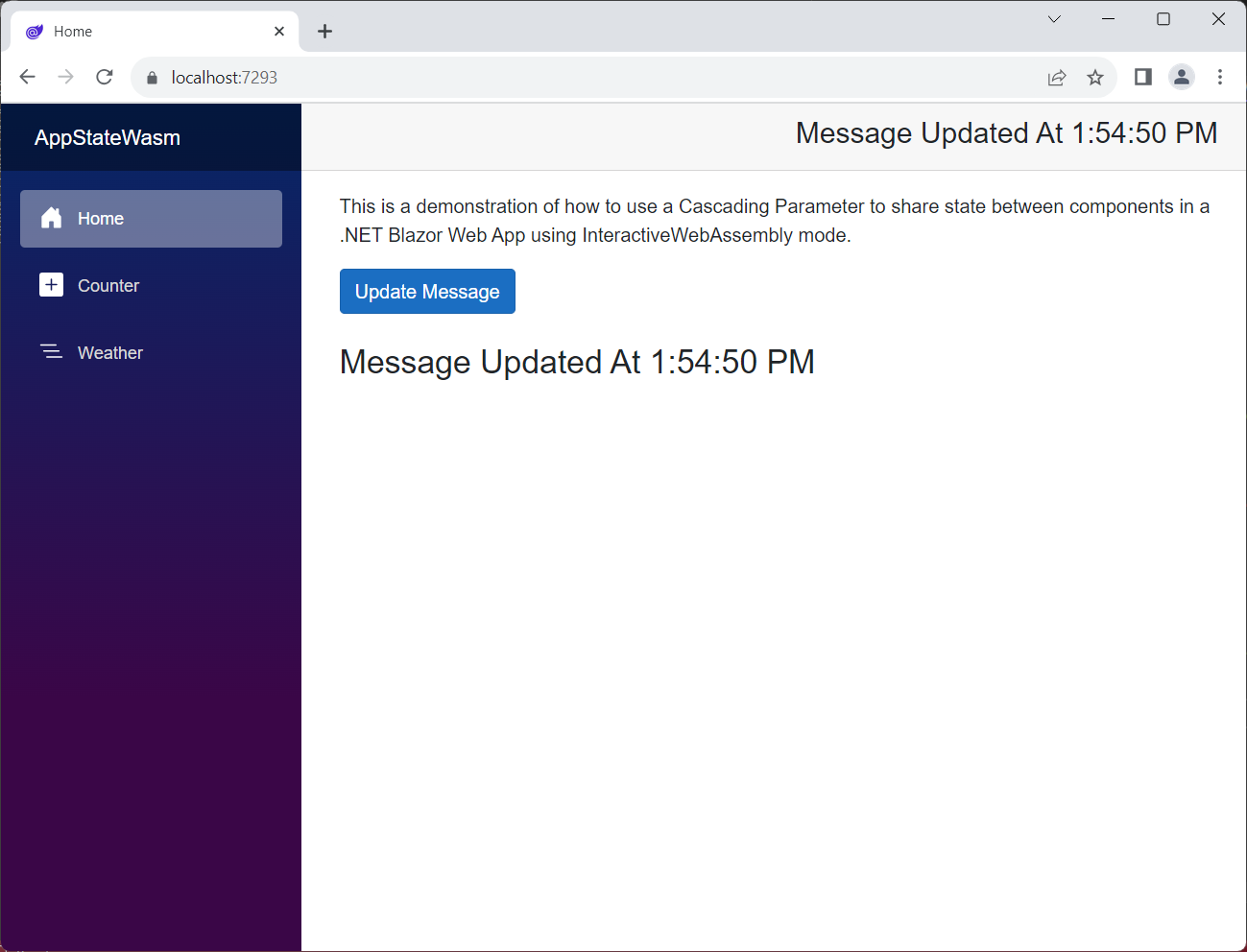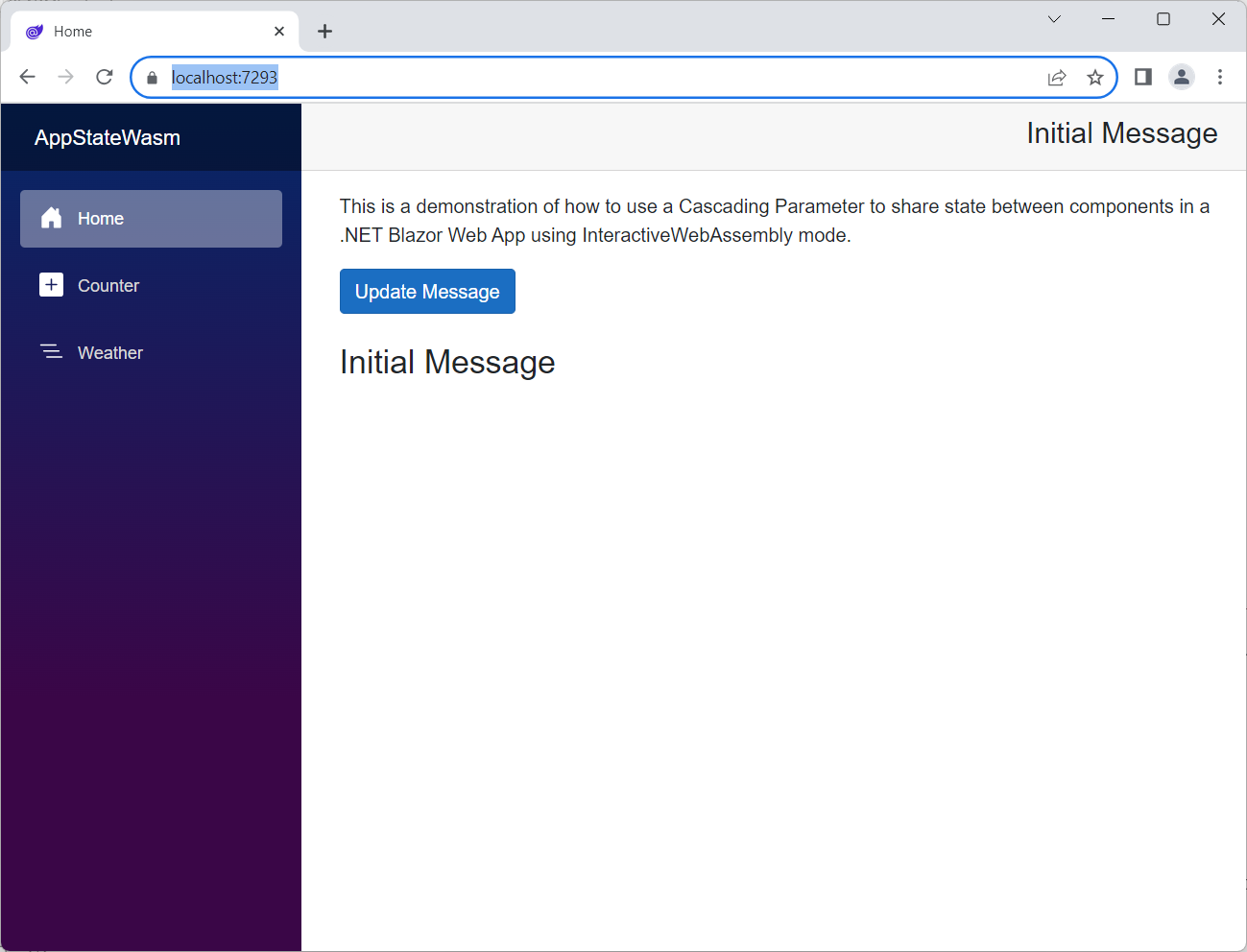This repo shows how to manage application state in a .NET 8 Blazor Web App using Interactive WebAssembly RenderMode.
See these other repos for demos using the other two render modes:
Application State (or app state) represents collectively all of the variables (objects, lists, etc.) that you keep alive in your application while in use. The default Blazor Sample App templates keep all variables in code blocks inside of pages. The problem with this approach is that those variables get reinitialized every time the page is navigated to or refreshed.
The key to app state is to move it to a component that lives outside of the pages so that
- variables persist between navigations and page refreshes
- variables can be shared by all pages and components
- We want UI to automatically update via binding whenever any of the properties update.
- We may want to get control when the state gets mutated.
Make sure you specify the following options:
Interactive render mode: WebAssembly
Interactivity Location: Global
Include sample pages: yes
The approach we will take is to use a Cascading component. This is essentially an object reference that can be accessed by any component in the render tree below where it is defined. If we want all pages and components to have access to it, we can wrap it around the Router in Routes.razor, but I'm getting ahead of myself.
Observe the default behavior
Run the app (F5)
Go to the Counter page and increment the counter, now navigate to the Home page (Home) and back to Counter. Notice that the counter has been reset to zero!
This is because the counter value itself (currentCount) is defined within the page.
@page "/counter"
<PageTitle>Counter</PageTitle>
<h1>Counter</h1>
<p role="status">Current count: @currentCount</p>
<button class="btn btn-primary" @onclick="IncrementCount">Click me</button>
@code {
private int currentCount = 0;
private void IncrementCount()
{
currentCount++;
}
}Whenever you navigate to a page, it is reinitialized. All of the module-level variables (such as currentCount) get reset to default values.
Let's fix that on our way to provide state to the entire app.
<CascadingValue Value="this">
@ChildContent
</CascadingValue>
@code {
[Parameter]
public RenderFragment ChildContent { get; set; }
/// <summary>
/// Implement property handlers like so
/// </summary>
private string message = "";
public string Message
{
get => message;
set
{
message = value;
StateHasChanged(); // Optionally force a re-render
}
}
private int count = 0;
public int Count
{
get => count;
set
{
count = value;
StateHasChanged();
}
}
protected override void OnInitialized()
{
Message = "Initial Message";
}
}A RenderFragment represents a chunk of Razor markup that can then be rendered by the component. Razor components can capture their child content as a RenderFragment and render that content as part of the component rendering. To capture child content, define a component parameter of type RenderFragment and name it ChildContent.
Using a RenderFragment named ChildContent tells the Blazor component engine that ChildContent is everything in the render tree below this component.
The property handlers must be explicit so that we can call StateHasChanged() when values are set. That tells the rendering engine that something has changed, and a redraw is necessary.
For more information on RenderFragments see https://learn.microsoft.com/en-us/aspnet/core/blazor/components/?view=aspnetcore-8.0#child-content-render-fragments:
<CascadingAppState>
<Router AppAssembly="@typeof(Program).Assembly">
<Found Context="routeData">
<RouteView RouteData="@routeData" DefaultLayout="@typeof(Layout.MainLayout)" />
<FocusOnNavigate RouteData="@routeData" Selector="h1" />
</Found>
</Router>
</CascadingAppState><div style="height:42px;">
<span style="font-size:x-large">@AppState.Message</span>
</div>
@code {
[CascadingParameter]
public CascadingAppState AppState { get; set; }
}The Toolbar will go across the top of the page.
Note that we grab the reference to CascadingAppState with the [CascadingParameter] attribute. It's almost the same as injection, except that it's optimized for use in Blazor components and pages.
Now we can refer to AppState and it's properties anywhere in the component. The values of those properties exist OUTSIDE the page, and will still be there if we reload the component.
@inherits LayoutComponentBase
<div class="page">
<div class="sidebar">
<NavMenu />
</div>
<main>
<div class="top-row px-4">
<Toolbar/>
</div>
<article class="content px-4">
@Body
</article>
</main>
</div>
<div id="blazor-error-ui">
An unhandled error has occurred.
<a href="" class="reload">Reload</a>
<a class="dismiss">🗙</a>
</div>@page "/"
<PageTitle>Home</PageTitle>
<p>
This is a demonstration of how to use a Cascading Parameter to share state between components
in a .NET Blazor Web App using InteractiveWebAssembly mode.
</p>
<button class="btn btn-primary" @onclick="UpdateMessageButtonClicked">Update Message</button>
<br />
<br />
<h3>@AppState.Message</h3>
@code
{
[CascadingParameter]
public CascadingAppState AppState { get; set; }
void UpdateMessageButtonClicked()
{
AppState.Message = $"Message Updated At {DateTime.Now.ToLongTimeString()}";
}
}Again, we're grabbing that cascading reference to CascadingAppState. Now we have two components with access to it, and they can both get and set it's properties.
@page "/counter"
<PageTitle>Counter</PageTitle>
<h1>Counter</h1>
<p role="status">Current count: @AppState.Count</p>
<button class="btn btn-primary" @onclick="IncrementCount">Click me</button>
@code {
[CascadingParameter]
public CascadingAppState AppState { get; set; }
private void IncrementCount()
{
// This is the only place AppState.Count is incremented
AppState.Count++;
}
}Here we have replaced currentCount with AppState.Count.
Go to the Counter page, and click the button. Now navigate to the Home page and back to the Counter page.
Notice that our counter page remembers the value between navigations. That's because it is being stored in the CascadingAppStateProvider!
Click the Update Message button, and notice that the text in the Toolbar changes automatically.
So far we have handled the situation where multiple components that access AppState properties can update their UI whenever one of those components changes an AppState property value.
What if a component needs to take action when a property value changes? For example, the Toolbar might want to send a message, make an API call, or the like.
One option is just to handle this inside the CascadingAppState.razor component's property setters. However, we may not want to give the AppState component such power over the application. In general, we should adhere to the Single Responsibility Principle.
In this case, we want to create a pub/sub mechanism by which each component/page can be notified when a property changes.
Modify the CascadingAppState.razor file with this:
<CascadingValue Value="this">
@ChildContent
</CascadingValue>
@code {
[Parameter]
public RenderFragment ChildContent { get; set; }
// Rather than having a Parameter, we are maintaining a list of callbacks
private List<EventCallback<StatePropertyChangedArgs>> Callbacks
= new List<EventCallback<StatePropertyChangedArgs>>();
// Each component will register a callback
public void RegisterCallback(EventCallback<StatePropertyChangedArgs> callback)
{
// Only add if we have not already registered this callback
if (!Callbacks.Contains(callback))
{
Callbacks.Add(callback);
}
}
// We call this from our property setters
private void NotifyPropertyChanged(StatePropertyChangedArgs args)
{
foreach (var callback in Callbacks)
{
// Ignore exceptions due to dangling references
try
{
// Invoke the callback
callback.InvokeAsync(args);
}
catch { }
}
}
/// <summary>
/// Implement property handlers like so
/// </summary>
private string message = "";
public string Message
{
get => message;
set
{
message = value;
// Force a re-render
StateHasChanged();
// Notify any listeners
NotifyPropertyChanged(new("Message", value));
}
}
private int count = 0;
public int Count
{
get => count;
set
{
count = value;
StateHasChanged();
NotifyPropertyChanged(new("Count", value));
}
}
protected override void OnInitialized()
{
Message = "Initial Message";
}
}Add StatePropertyChangedArgs.cs to the client:
/// <summary>
/// This record is used to pass the name of the property that
/// changed and the new value of the property.
/// </summary>
/// <param name="PropertyName"></param>
/// <param name="NewValue"></param>
public record StatePropertyChangedArgs(string PropertyName, object? NewValue);Now CascadingAppState will notify all the components that have registered whenever a property changes.
You absolutely could. However, the Blazor Component Model gives us the EventCallback, the handlers for which do not have to be unhooked, and therefore the consumers of them do not need to implement IDisposable.
Modify Toolbar.razor to handle the EventCallback:
<div style="height:42px;">
<span style="font-size:x-large">@AppState.Message</span>
</div>
@code {
[CascadingParameter]
public CascadingAppState AppState { get; set; }
protected override void OnInitialized()
{
AppState.RegisterCallback(EventCallback.Factory.Create<StatePropertyChangedArgs>(this, HandlePropertyChanged));
}
private void HandlePropertyChanged(StatePropertyChangedArgs args)
{
// Now the toolbar can be notified when any AppState property changes, and retrieve the new value
}
}Set a breakpoint in the Toolbar's HandlePropertyChanged method. Run the app and click the Update Message button.
If you inspect the args value, the PropertyName will be "Message", and NewValue will be the value that it was just set to.
It would be great if we could save certain AppState properties so that they will come back the next time the app is run.
Here's a scenario: You have a large set of input form fields that the user needs to fill out. After meticulously entering 99% of their data, they have to take a phone call during which the form times out, the computer reboots, or some other issue forces them to refresh the page. All that work is for nothing.
By keeping their form values in AppState properties, and persisting those properties to their local storage area in their browser, we can retrieve the values the next time they log in.
What's more, we can keep track of other data such as what page they were using, or any other session-scoped variables that we'd like to persist between sessions.
In this example, we will also implement a time window, after which we will NOT reload their AppState property values. Another option would be to ask the user if they'd like to continue where they left off whenever they log in.
We will need access to LocalStorage. For this we will use Chris Sainty's Blazored.LocalStorage pagckage.
Add the following package reference to both the server and client projects:
Install-Package Blazored.LocalStorage
or
<PackageReference Include="Blazored.LocalStorage" Version="4.4.0" />Add this to Program.cs in both projects:
builder.Services.AddBlazoredLocalStorage();You'll need this:
using Blazored.LocalStorage;We are going to separate the properties we want to persist into an interface.
That will allow us to serialize just those properties to JSON.
Add the following class to the client project:
IAppState.cs
namespace AppStateWasm.Client;
public interface IAppState
{
string Message { get; set; }
int Count { get; set; }
DateTime LastStorageSaveTime { get; set; }
}System.Text.Json will not deserialize to an interface, so we have to create a class that implements the interface:
namespace AppStateWasm.Client;
public class AppState : IAppState
{
public string Message { get; set; } = string.Empty;
public int Count { get; set; }
public DateTime LastStorageSaveTime { get; set; }
}Now replace CascadingAppState.razor with the following:
<CascadingValue Value="this">
@ChildContent
</CascadingValue>Add a code-behind file named CascadingAppState.razor.cs:
using Microsoft.AspNetCore.Components;
using Blazored.LocalStorage;
using System.Text.Json;
namespace AppStateWasm.Client;
public partial class CascadingAppState : ComponentBase, IAppState
{
private readonly string StorageKey = "MyAppStateKey";
private readonly int StorageTimeoutInSeconds = 30;
bool loaded = false;
public DateTime LastStorageSaveTime { get; set; }
[Inject]
ILocalStorageService localStorage { get; set; }
[Parameter]
public RenderFragment ChildContent { get; set; }
// Rather than having a Parameter, we are maintaining a list of callbacks
private List<EventCallback<StatePropertyChangedArgs>> Callbacks
= new List<EventCallback<StatePropertyChangedArgs>>();
// Each component will register a callback
public void RegisterCallback(EventCallback<StatePropertyChangedArgs> callback)
{
// Only add if we have not already registered this callback
if (!Callbacks.Contains(callback))
{
Callbacks.Add(callback);
}
}
// We call this from our property setters
private void NotifyPropertyChanged(StatePropertyChangedArgs args)
{
foreach (var callback in Callbacks)
{
// Ignore exceptions due to dangling references
try
{
// Invoke the callback
callback.InvokeAsync(args);
}
catch { }
}
}
/// <summary>
/// Implement property handlers like so
/// </summary>
private string message = "";
public string Message
{
get => message;
set
{
message = value;
// Force a re-render
StateHasChanged();
// Notify any listeners
NotifyPropertyChanged(new("Message", value));
// Save to local storage
new Task(async () =>
{
await Save();
}).Start();
}
}
private int count = 0;
public int Count
{
get => count;
set
{
count = value;
StateHasChanged();
NotifyPropertyChanged(new("Count", value));
new Task(async () =>
{
await Save();
}).Start();
}
}
protected override async Task OnAfterRenderAsync(bool firstRender)
{
if (firstRender)
{
await Load();
loaded = true;
StateHasChanged();
}
}
protected override void OnInitialized()
{
Message = "Initial Message";
}
public async Task Save()
{
if (!loaded) return;
// set LastSaveTime
LastStorageSaveTime = DateTime.Now;
// serialize
var state = (IAppState)this;
// save
await localStorage.SetItemAsync<IAppState>(StorageKey, state);
}
public async Task Load()
{
try
{
var json = await localStorage.GetItemAsStringAsync(StorageKey);
if (json == null || json.Length == 0) return;
var state = JsonSerializer.Deserialize<AppState>(json);
if (state != null)
{
if (DateTime.Now.Subtract(state.LastStorageSaveTime).TotalSeconds <= StorageTimeoutInSeconds)
{
// decide whether to set properties manually or with reflection
// comment to set properties manually
//this.Message = state.Message;
//this.Count = state.Count;
// set properties using Reflection
var t = typeof(IAppState);
var props = t.GetProperties();
foreach (var prop in props)
{
if (prop.Name != "LastStorageSaveTime")
{
object value = prop.GetValue(state);
prop.SetValue(this, value, null);
}
}
}
}
}
catch (Exception ex)
{
}
}
}Notice that we are implementing IAppState so we can easily serialize and deserialize just those properties.
Check out Save():
public async Task Save()
{
if (!loaded) return;
// set LastSaveTime
LastStorageSaveTime = DateTime.Now;
// serialize
var state = (IAppState)this;
// save
await localStorage.SetItemAsync<IAppState>(StorageKey, state);
}This gets called from our property setters.
Any time a property is changed, all the values of all the properties in IAppState will be saved in local storage.
NOTE: Everything still works as before, but now we can persist all the properties exposed by the Interface.
Now check out Load(), which is called fromOnAfterRenderAsync :
public async Task Load()
{
try
{
var json = await localStorage.GetItemAsStringAsync(StorageKey);
if (json == null || json.Length == 0) return;
var state = JsonSerializer.Deserialize<AppState>(json);
if (state != null)
{
if (DateTime.Now.Subtract(state.LastStorageSaveTime).TotalSeconds <= StorageTimeoutInSeconds)
{
// decide whether to set properties manually or with reflection
// comment to set properties manually
//this.Message = state.Message;
//this.Count = state.Count;
// set properties using Reflaction
var t = typeof(IAppState);
var props = t.GetProperties();
foreach (var prop in props)
{
if (prop.Name != "LastStorageSaveTime")
{
object value = prop.GetValue(state);
prop.SetValue(this, value, null);
}
}
}
}
}
catch (Exception ex)
{
}
}This happens after the first render.
We're reading the JSON from local storage, deserializing it into an AppState object (remember, we can't serialize to an interface), and then using reflection to set the values that are part of our interface.
Press F5 and press the Update Message button. You can also update the counter if you like.
Close the app right after making a change, and then run it again within 30 seconds. The AppState will load from LocalStorage:
If you close the app and wait at least 30 seconds before running it again, the AppState gets reset and you're back to square one.
The IAppStae interface and the AppState class determine which properties get persisted, and you can modify them at will. The only requirement is that the properties must be implemented in CascadingAppState.razor.
Try it! Remove a property from both IAppState and AppState. Run the app and test the persistence.
